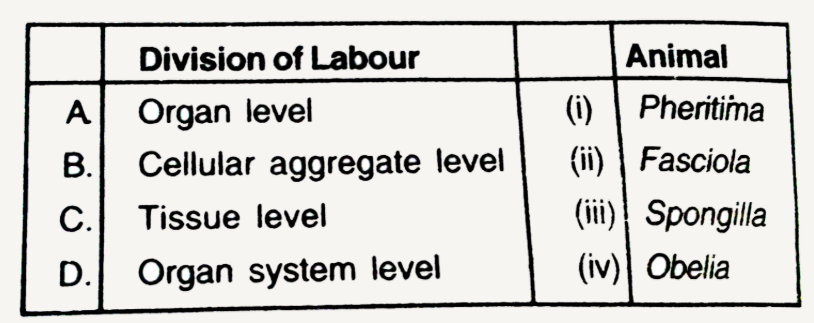Match the following list of animals with their level of organisation.
Division of LabourAnimalA.Organ leveli.PheretimaB.Cellular aggregate levelii.FasciolaC.Tissue leveliii.SpongillaD.Organ system leveliv.Obelia
Choose the correct match showing division of labour with animal example.
(i)-B, (ii)-C, (iii)-D and (iv)-A
(i)-B, (ii)-D, (iii)-C and (iv)-A
(i)-D, (ii)-A, (iii)-B and (iv)-C
(i)-A, (ii)-D, (iii)-C and (iv)-B
The correct Answer is:C
To solve the question of matching animals with their level of organization, we need to analyze each animal and determine its corresponding level of organization. Here’s a step-by-step solution:
Step 1: Identify the Levels of Organization
1. Cellular Aggregate Level: This level involves simple organisms that are made up of a collection of cells that perform similar functions but do not form true tissues.
2. Tissue Level: At this level, cells are organized into tissues that perform specific functions.
3. Organ Level: Here, different types of tissues come together to form organs that perform specific functions.
4. Organ System Level: This is a higher level of organization where different organs work together to perform complex functions.
Step 2: Analyze Each Animal
1. Pheretima (Earthworm): This organism has a complex structure with various organs working together, indicating it has an Organ System Level of organization.
2. Fasciola (Liver Fluke): This organism has some organs but does not possess a complete organ system, so it is classified under the Organ Level of organization.
3. Spongilla (Freshwater Sponge): As a member of the Porifera, Spongilla has a simple structure with a cellular aggregate level of organization.
4. Obelia: This organism has a more complex structure with tissues, indicating it has a Tissue Level of organization.
Step 3: Match Each Animal with Its Level of Organization
- A. Organ Level → ii. Fasciola
- B. Cellular Aggregate Level → iii. Spongilla
- C. Tissue Level → iv. Obelia
- D. Organ System Level → i. Pheretima
Final Matches
- A (Organ Level) → ii (Fasciola)
- B (Cellular Aggregate Level) → iii (Spongilla)
- C (Tissue Level) → iv (Obelia)
- D (Organ System Level) → i (Pheretima)
Summary of the Correct Matches
- A - ii
- B - iii
- C - iv
- D - i
1. Cellular Aggregate Level: This level involves simple organisms that are made up of a collection of cells that perform similar functions but do not form true tissues.
2. Tissue Level: At this level, cells are organized into tissues that perform specific functions.
3. Organ Level: Here, different types of tissues come together to form organs that perform specific functions.
4. Organ System Level: This is a higher level of organization where different organs work together to perform complex functions.
1. Pheretima (Earthworm): This organism has a complex structure with various organs working together, indicating it has an Organ System Level of organization.
2. Fasciola (Liver Fluke): This organism has some organs but does not possess a complete organ system, so it is classified under the Organ Level of organization.
3. Spongilla (Freshwater Sponge): As a member of the Porifera, Spongilla has a simple structure with a cellular aggregate level of organization.
4. Obelia: This organism has a more complex structure with tissues, indicating it has a Tissue Level of organization.
- A. Organ Level → ii. Fasciola
- B. Cellular Aggregate Level → iii. Spongilla
- C. Tissue Level → iv. Obelia
- D. Organ System Level → i. Pheretima
- A (Organ Level) → ii (Fasciola)
- B (Cellular Aggregate Level) → iii (Spongilla)
- C (Tissue Level) → iv (Obelia)
- D (Organ System Level) → i (Pheretima)
- A - ii
- B - iii
- C - iv
- D - i
Topper's Solved these Questions
- BOOK - NCERT EXEMPLAR ENGLISHCHAPTER - ANIMAL KINGDOMEXERCISE - VERY SHORT ANSWER TYPE QUESTIONS15videos
ANIMAL KINGDOM
- BOOK - NCERT EXEMPLAR ENGLISHCHAPTER - ANIMAL KINGDOMEXERCISE - SHORT ANSWER TYPE QUESTIONS13videos
ANIMAL KINGDOM
- BOOK - NCERT EXEMPLAR ENGLISHCHAPTER - ANATOMY OF FLOWERING PLANTSEXERCISE - Long Answer6videos
ANATOMY OF FLOWERING PLANTS
- BOOK - NCERT EXEMPLAR ENGLISHCHAPTER - BIOLOGICAL CLASSIFICATIONEXERCISE - Long answer5videos
BIOLOGICAL CLASSIFICATION
Similar Questions
Match the following list of animals with their level of organisation.
Choose the correct match sryowing division of labour with animal example.
 View Solution
View SolutionMatch the following list of animals with their level of organisation :

Choose the correct match showing division of labour with animals.View Solution
Knowledge Check
- Question 1 - Select One
Match the following list of bacteria and their commercially important products.
BacteriumProduct(i)Aspergillus niger(A)Lactic acid(ii)Acetobacter aceti(B)Butyric acid(iii)Clostridium butylicum(C)Acetic acid(iv)Lactobacillus(D)Citric acid
Choose the correct match.Ai−(B),ii−(C),iii−(D),iv−(A)Bi−(B),ii−(D),iii−(C),iv−(A)Ci−(D),ii−(C),iii−(B),iv−(A)Di−(D),ii−(A),iii−(C),−iv−(B)
In which of the following phylum all the animals are exclusively marine with organ system level of organisation?
View SolutionMatch the animals given in column A with their location in column B.
Column AColumn B(i)DodoA.Africa(ii)QuaggaB.Russia(iii)ThylacineC.Mauritius(iv)Stellar's sea cowD.Australia
Choose the correct match from the following.View SolutionMatch the followings and choose correct option.
Group AGroup BA.Aleurone layer(ii)Without fertilisationB.Parthenocarpic fruit(ii)NutritionC.Ovule(iii)Double fertilisationD.Endosperm(iv)SeedView SolutionMatch the following list of bacteria and their commercially important products.
BacteriumProduct(i)Aspergillus niger(A)Lactic acid(ii)Acetobacter aceti(B)Butyric acid(iii)Clostridium butylicum(C)Acetic acid(iv)Lactobacillus(D)Citric acid
Choose the correct match.View SolutionMatch the animals given in column A with their location in column B.
Column AColumn B(i)DodoA.Africa(ii)QuaggaB.Russia(iii)ThylacineC.Mauritius(iv)Stellar's sea cowD.Australia
Choose the correct match from the following.
(a) i-A, ii-C, iii-B, iv-D
(b) i-D, ii-C, iii-A, iv-B
(c) i-C, ii-A, iii-B, iv-D
(d) i-C, ii-A, iii-D, iv-BView SolutionMatch the following column I with column II and choose the correct combination.
ColumnIColumnII(a)Earthworm(i)Gizzard(b)Cockroach(ii)Caecum(c)Frog(iii)Clitellum(d)Rat(iv)CloacaView SolutionMatch the following and choose the correct answer
A.Touch(i)Nasal epitheliumB.Smell(ii)Foramen magnumC.Cranial nerves(iii)Sensory papilaeD.Medulla oblongata(iv)Peripheral nervous systemView Solution

